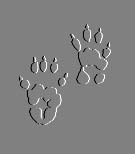TRACKING
Following the tracks of an animal can teach you much about what it eats, where it sleeps, and its daily habits. Your tracking skill may lead you right to the animal itself
Tracking is not limited to following mammals
Insects leave tracks, too. So do reptiles. You can spend an hour of careful tracking and not move more than a few feet. In fact, if you can track a beetle through the jungles of a grassy lawn, you probably have the skill to track larger animals across any terrain.
Tracking is a skill...
...that you can learn only by doing a lot of it. You can learn in your own yard, vacant lots, fields, and forests. The following guidelines will help you get started:
First, find some tracks!
You must find some tracks before you can follow them. Winter snows hold a surprising number of tracks. During other seasons, try the soft soil near ponds and streams. In dry country, scan the dust for prints and look for pebbles and rocks that have been disturbed.
Study a single track
Get down on your hands and knees to study the shape of the track you wish to follow. Fix its details in your mind. You might even measure it and make a sketch of it. That will help you find it later, even when other tracks are mixed in with it. Use a tracking guide to identify the tracks, and the animal that made them.
Track early or late
Tracking is easiest early in the morning and late in the day, when shadows cast in the prints make them more obvious.
Look for more than just the prints
As you follow a trail of tracks, keep your eyes peeled for other evidence of the animal. Bent grass, broken twigs, and displaced pebbles help you see the animal's path. Watch for places where the animal has scratched or rubbed against trees or rocks.
Droppings
Animal dropings or 'scat' give evidence of an animal's diet. Break scat apart with a stick. Hulls of seeds, skins of berries, and bits of leaves suggest the animal is a vegetarian. Small bones, fur, and feathers appear in the scat of meat eaters. Scat tends to dry from the outside in. If it is completely dry, you know the animal passed by some time ago. Moist scat was left more recently. The animal may be near.
Imagine yourself in the place of the animal
If you lose the trail, ask your self where you would go if you were the animal. Look in that direction. Mark the last track with a stick, then explore all around it until you find the trail again.
Notice important landmarks as you proceed
Don't become so interested in following a trail that you get lost. Be alert to your surroundings. Notice and remember landmarks that will guide you back to your starting point.
Don't disturb human artifacts
Over the centuries, humans have left traces of their passing. You may be fortunate enough to discover an arrowhead, broken pottery, or other artifacts of earlier cultures. If so, let them lie where you find them. Note the location very well and draw a map so you can find the spot again. Then alert local authorities. They will know if archaeologists should examine the site. The position in which artifacts are found can tell scientists a great deal about the people who made and used them. That's why it is important not to disturb them.
COLLECTING TRACKS
Perhaps you've heard the old saying about low-impact hiking: "Take only photographs, leave only footprints." By making plaster casts, you can bring home some footprints, too.
When you find a track you want to preserve, mix up some plaster of paris. (You can get the plaster at a drugstore. The label will have mixing instructions.) Turn a cardboard strip into a collar by notching the ends together. Place the collar around the track and pour in the mix. Let it harden - 10 to 15 minutes in warm weather. Remove it and brush off the dirt. On the back of the cast, write the date and the location where you found the track.
You can also cast plaster molds of tracks in the snow. In addition to plaster of paris, you'll need a mist bottle such as those used with window cleaner. Spray the track with a fine mist of water and wait a few moments while it freezes. Mix the plaster using cold water (warm plaster will melt the print). Put a collar around the track and pour in plaster. Allow it time to harden.
By themselves, casts of prints are fine souvenirs of your adventures. You can also press them into damp sand to recreate the original prints - a valuable study aid for improving the tracking skills of everyone in your patrol.
FUN WITH TRACKING
You can practice tracking just about anywhere. At home, try sneaking up on the family dog, the cat, and your brothers and sisters. In camp, sit very quietly near a trail and see how many Scouts pass by without noticing you. Would you like to play some tracking and stalking games with your den or patrol? Here is one that have been popular with Scouts for many years:
Cross-Country Runner
The Scout who is the runner has a 1-minute head start. Every few steps he drops a few kernels of corn. The others in the patrol follow the kernel trail and try to catch up with the runner before he reaches a finish line about a mile away.
|

